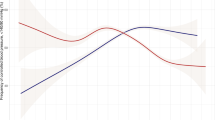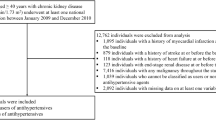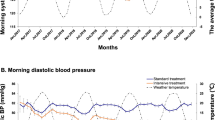Abstract
Cardiovascular death represents the single largest cause of mortality in women with 70% of deaths attributable to modifiable risk factors, such as hypertension. This analysis aims at evaluating, whether there are gender disparities in antihypertensive drug usage and blood pressure (BP) control. We included 18 017 patients with arterial hypertension from the International Survey Evaluating Microalbuminuria Routinely by Cardiologists in patients with Hypertension (I-SEARCH). The study was conducted between September 2005 and March 2006 in 26 countries, and data on patient demographics, cardiovascular disease and risk factors, BP, and cardiovascular drug treatment were collected. Mean systolic blood pressure (SBP) was 2.1 mm Hg higher in women (150.6±0.35 mm Hg, n=8357/18 017) than in men (148.5±0.35 mm Hg; P<0.0001, n=9526/18 017), whereas no difference in diastolic BP was seen (88.2±0.20 vs 88±0.20 mm Hg; P=0.198). Gender differences in SBP were more pronounced in diabetic as compared with non-diabetic patients (3.5 vs 1.7 mm Hg, n=4272 vs n=13 611; P<0.0001) and became evident at an age 55 years old. Overall BP-control rate was 33.6% in men and 30.6% in women (P<0.0001) and was lower in diabetic as compared with non-diabetic patients. In all, 30% of patients used one, 40% used two and 30% used ⩾3 drugs without gender differences. Response rates to different drug regimens appeared to be similar. However, women received more frequently thiazides and β-blockers, and less frequently ACE-inhibitors as monotherapy. Major efforts are required to improve BP-management, especially in women.
This is a preview of subscription content, access via your institution
Access options
Subscribe to this journal
Receive 12 digital issues and online access to articles
$119.00 per year
only $9.92 per issue
Buy this article
- Purchase on Springer Link
- Instant access to full article PDF
Prices may be subject to local taxes which are calculated during checkout






Similar content being viewed by others
References
Kearney PM, Whelton M, Reynolds K, Muntner P, Whelton PK, He J . Global burden of hypertension: analysis of worldwide data. Lancet 2005; 365: 217–223.
Bramlage P, Thoenes M, Kirch W, Lenfant C . Clinical practice and recent recommendations in hypertension management—reporting a gap in a global survey of 1259 primary care physicians in 17 countries. Curr Med Res Opin 2007; 23: 783–791.
Bakris G, Hill M, Mancia G, Steyn K, Black HR, Pickering T et al. Achieving blood pressure goals globally: five core actions for health-care professionals. A worldwide call to action. J Hum Hypertens 2008; 22: 63–70.
Prospective Studies Collaboration. Age-specific relevance of usual blood pressure to vascular mortality: a meta-analysis of individual data for one million adults in 61 prospective studies. Lancet 2002; 360: 1903–1913.
Gueffiyer F, Boutitie F, Boissel JP, Pocock S, Coope J, Cutler J et al. Effect of antihypertensive drug treatment on cardiovascular outcomes in women and men. A metaanalysis of individual patient data from randomised controlled trials. Ann Intern Med 1997; 126: 761–767.
Turnbull F, Woodward M, Neal B, Barzi F, Ninomyya T, Chalmers J et al. Do men and women respond differently to blood pressure-lowering treatment? Results of prospectively designed overviews of randomized trials. Eur Heart J 2008; 29: 2669–2680.
Quan A, Kerlikowske K, Gueffiyer F, Boissel JP, the INDIANA investigators. Efficacy of treating hypertension in women. J Gen Intern Med 1999; 14: 718–729.
Abuful A, Gidron Y, Henkin Y . Physicians’ attitude toward preventive therapy for coronary artery disease: is there a gender bias? Clin Cardiol 2005; 28: 389–393.
Holroyd-Leduc JM, Kapral MK, Austin PC, Tu JV . Sex differences and similarities in the management and outcome of stroke patients. Stroke 2000; 31: 1833–1837.
Wexler DJ, Grant RW, Meigs JB, Nathan DM, Cagliero E . Sex disparities in treatment of cardiac risk factors in patients with type 2 diabetes. Diabetes Care 2005; 28: 514–520.
Lloyd-Jones DM, Evans JC, Levy D . Hypertension in adults across the spectrum: current outcomes and control in the community. JAMA 2005; 294: 466–472.
Kjeldsen SE, Naditch-Brule L, Perlini S, Zidek W, Farsang C . Increased prevalence of metabolic syndrome in uncontrolled hypertension across Europe: the global cardiometabolic risk profile in patients with hypertension disease survey. J Hypertens 2008; 26: 2064–2070.
Böhm M, Thoenes M, Danchin N, Bramlage P, Lapuerta P, Volpe M . Association of cardiovascular risk factors to microalbuminuria in hypertensive individuals. The i-SEARCH global study. J Hypertens 2007; 25: 2317–2324.
Ong KL, Tso AWK, Lam KSL, Cheung BMY . Gender difference in blood pressure control and cardiovascular risk factors in Americans with diagnosed hypertension. Hypertension 2008; 51: 1142–1148.
Wolf-Maier K, Cooper RS, Kramer H, Banegas JR, Giampaoli S, Joffres MR et al. Hypertension treatment and control in five European countries, Canada, and the United States. Hypertension 2004; 43: 10–17.
Lewington S, Clarke R, Qizilbash N, Peto R, Collins R . Prospective Studies Collaboration. Age-specific relevance of usual blood pressure to vascular mortality; a meta-analysis of individual data for one million adults in 61 prospective studies. Lancet 2002; 360: 1903–1913.
Heart Disease and Stroke Statistics 2009 Update. A report from the American Heart Association Statistics Committee and Stroke Statistics Subcommittee. Circulation 2009; 119: 480–486.
Casiglia E, Tikhonoff V, Mazza A, Piccoli A, Pessina AC . Pulse pressure and coronary mortality in elderly men and women from general population. J Hum Hypertens 2002; 16: 611–620.
Mancia G, Grassi G . Systolic and diastolic blood pressure control in antihypertensive drug trials. J Hypertens 2002; 20: 1461–1464.
Gu Q, Burt VL, Paulose-Ram R, Dillon CF . Gender differences in hypertension treatment, drug utilization patterns, and blood pressure control among US adults with hypertension: Data from the National Health and Nutrition Examination Survey 1999–2004. Am J Hypertens 2008; 21: 789–798.
Keyhani S, Scobie JV, Hebert P, McLaughlin MA . Gender disparities in blood pressure control and cardiovascular care in a national sample of ambulatory care visits. Hypertension 2008; 51: 1149–1155.
McInnis NH, Fodor G, Lum-Kwong MM, Leenen FHH . Antihypertensive medication use and blood pressure control: a community-based cross-sectional survey (ON-BP). Am J Hypertens 2008; 21: 1210–1215.
Visser LE, Stricker BH, van der Velden J . Angiotensin converting enzyme inhibitor associated cough: a population-based case-control study. J Clin Epidemiol 1995; 48: 851–857.
Bolland MJ, Ames RW, Horne AM . The effect of treatment with thiazide diuretic for 4 years on bone density in normal postmenopausal women. Osteoporos Int 2007; 18: 479–486.
Taler SJ . Hypertension in women. Curr Hypertens Rep 2009; 11: 23–28.
2003 European Society of Hypertension-European Society of Cardiology guidelines for the management of arterial hypertension. Guidelines Committee. J Hypertens 2003; 21: 1001–1053.
Acknowledgements
This study was funded by a research grant of Sanofi Aventis. MT, MB, MV and BVK received support from Sanofi Aventis. We thank Sam Zhong for the statistical support provided. HRN and MB are supported by a grant of the Deutsche Forschungsgemeinschaft (KFO 196: NE 1460/1-1 and Zentralprojekt).
Author information
Authors and Affiliations
Corresponding author
Rights and permissions
About this article
Cite this article
Thoenes, M., Neuberger, HR., Volpe, M. et al. Antihypertensive drug therapy and blood pressure control in men and women: an international perspective. J Hum Hypertens 24, 336–344 (2010). https://doi.org/10.1038/jhh.2009.76
Received:
Revised:
Accepted:
Published:
Issue Date:
DOI: https://doi.org/10.1038/jhh.2009.76
Keywords
This article is cited by
-
Evaluating Provider and Pharmacy Discordance in Potential Calcium Channel Blocker–Loop Diuretic Prescribing Cascade
Drugs & Aging (2024)
-
Can blood pressure decrease after maximal exercise test predict the blood pressure lowering effect of aerobic training in treated hypertensive men?
Journal of Human Hypertension (2023)
-
Incidence of severe hypokalaemia in patients taking indapamide
Internal and Emergency Medicine (2023)
-
Gender gaps in type 1 diabetes care
Acta Diabetologica (2023)
-
Roadmap for the Management of Type 2 Diabetes and Hypertension in the Middle East: Review of the 2022 EVIDENT Summit
Advances in Therapy (2023)



